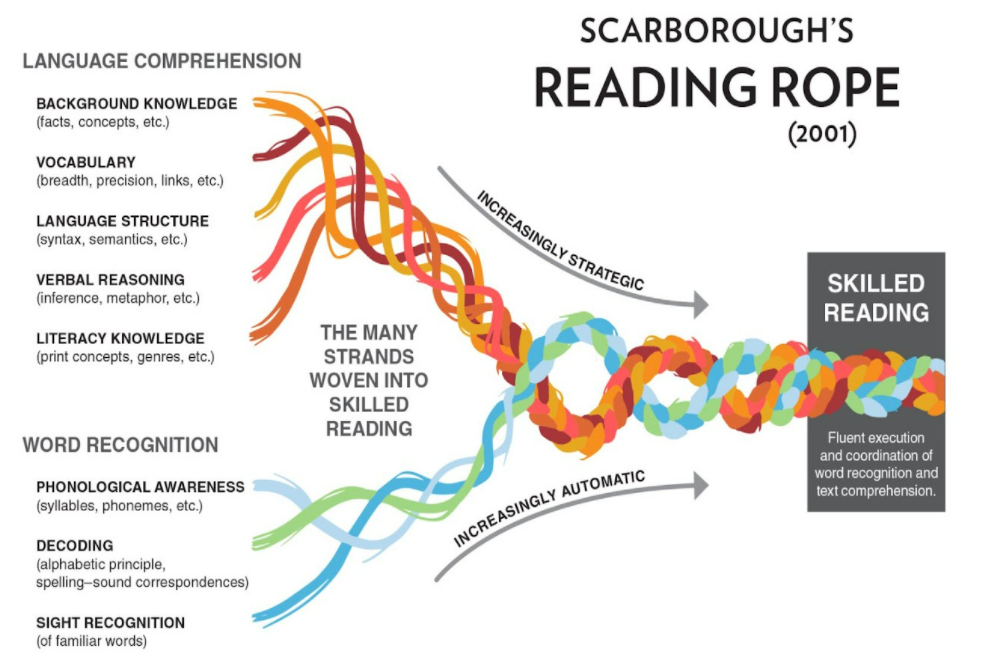What is Reading?
POSTED ON: December 13, 2021

“My child struggles with reading.”
It’s a phrase that many of us in the dyslexia world are familiar with; WE may have even said it before! As a speech-language pathologist, I have heard it said by educators, parents, and even family members. My response each time is “Can you tell me what you mean by reading?”
Usually, I get one of these responses:
- A confused look because I work with children with reading disorders—assuming I should know what they’re talking about.
- I’m doubting their child is truly struggling so they think I’m trying to prove them wrong
- They suddenly realize reading is much more complex and they take a few seconds to think about what they really mean by reading
While a parent is thinking about what their child is genuinely struggling with, I usually take out a pen and paper and write out an equation: D X LC = RC
I teach that our ability to successfully comprehend what we’re reading is measured by our ability to accurately and efficiently decode (matching the sounds and symbols put together to create a word) multiplied by our ability to accurately and efficiently comprehend language.
In other words, our ability to comprehend that the letters d-o-g represent an animal with four legs that bark depends on our ability to match the three letters to their sounds correctly and efficiently, and to have the previous knowledge of what a dog is by having heard the word, seen a dog, and having it labeled, or another way.
If a child is only struggling with the decoding aspect of reading, then intervention should target the decoding aspect of reading only. Where it gets more complicated however, is that some children with dyslexia also have difficulty with vocabulary, morphology (the basic units of meaning within a word, like how a plural -s can change the meaning of one dog to multiple dogs), and comprehension of grammar. Children with dyslexia are at-risk for developmental language disorder (DLD), which negatively impacts language development in areas such as vocabulary and grammar (Adlof & Hogan, 2018).
In a study by Catts and colleagues, 17-36% of kindergarteners with DLD also met the criteria for dyslexia in second through eighth grades, depending on whether or not the clinician took into account the child’s IQ when diagnosing dyslexia. When IQ was referenced, rates were 14-19%, however when IQ was not referenced, rates were between 31-35%. Another study estimated that at least half of children diagnosed with reading disabilities will have co-occurring DLD (G.M. McArthur et al, 2000). This begs the question as to why DLD and dyslexia tend to overlap in children.

Scarborough’s Reading Rope provides great insight on this subject. Dyslexia is impacted by the word recognition aspect of the Reading Rope (similar to the Decoding part of the Gough and Tunmer equation). Word recognition involves the phonological component of language, a central component in the diagnosis of dyslexia. DLD, on the other hand, is negatively impacted by non-phonological aspects of language, including syntax (grammar) morphology, and discourse (which involves communicating effectively across sentences, like retelling a story cohesively). Syntax, morphology, and discourse can easily overlap with phonology (basic units of sound). For example, if a second grader has difficulty recognizing the pattern of -ed as a past tense verb form and thinks of it as represented by the letter t because that’s what the child hears, then they may not use past tense -ed consistently as a simple past tense form. That could easily translate into errors in writing and incorrectly reading the word “baked” as “bakt.”
Rather than create unnecessary stress for a parent or teacher reading this, the goal is to be more aware of how dyslexia can interact with difficulties in other areas of language. When a child is diagnosed with dyslexia, some evaluators may only assess phonological awareness and decoding skills in order to give a diagnosis. However, children with dyslexia may have what we call subclinical deficits in areas of language comprehension–meaning their struggles do not warrant a diagnosis of DLD but such struggles should be monitored and supported through accommodations or modifications. Teamwork between parents, teachers, and other professionals is vital for addressing a child’s reading strengths and weaknesses.
References:
Adlof, S. M., & Hogan, T. P. (2018). Understanding dyslexia in the context of developmental language disorders. Language, Speech, and Hearing Services in Schools, 49(4), 762–773.
Catts, H. W., Adlof, S.M., Hogan, T. P.,& Weismer, S. E. (2005). Are specific language impairment and dyslexia distinct disorders? Journal of Speech, Language, and Hearing Research, 48, 1378–1396
Gough, P. B., & Tunmer, W. E. (1986). Decoding, reading, and reading disability. RASE: Remedial and Special Education, 7, 6–10.
McArthur, G. M., Hogben, J. H., Edwards, V. T., Heath, S. M., & Mengler, E. D. (2000). On the “specifics” of specific reading disability and specific language impairment. Journal of Child
Psychology and Psychiatry, and Allied Disciplines, 41(7), 869–874.
Scarborough, H. S. (2009). Connecting early language and literacy
to later reading disabilities: Evidence, theory, and practice. In F. Fletcher-Campbell, J. Soler, & G. Reid (Eds.), Approaching difficulties in literacy development: Assessment, pedagogy, and
programmes (pp. 23–39). Los Angeles, CA: Sage Publishing.
Red Square Pegs was established to empower dyslexics by embracing dyslexia through awareness and shared experiences and to be a symbol of acceptance, pride, and confidence.

